Reflector, Mirror, Small-arms, .303-Inch
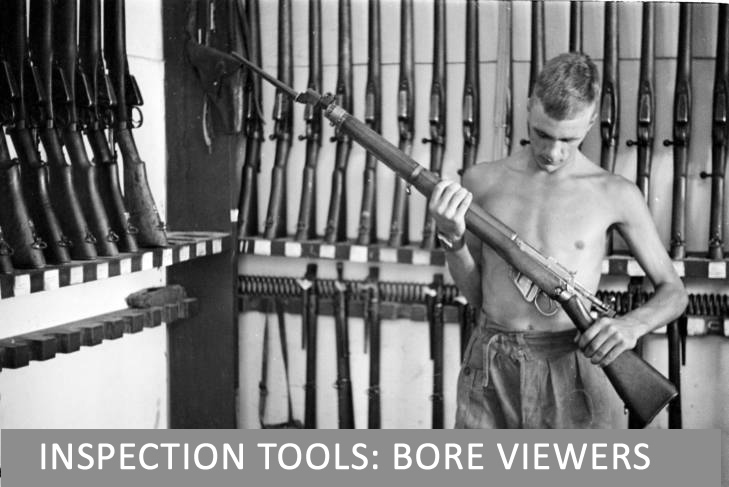
Photo notes: Hong Kong, Royal Army Service Corps (unidentified) soldier inspecting Lee-Enfield rifle. Photographer Forman, Harrison (1904-1978); taken circa 1950s. Photo fr302068; Harrison Forman Collection. [1]
A bore viewer is a tool that is used to visually inspect the interior of a rifle barrel. The earliest and simplest versions used a glass mirror to reflect ambient light into the rifle chamber as the user looked into the muzzle. The light would reflect brightly off surfaces that were clean and polished.
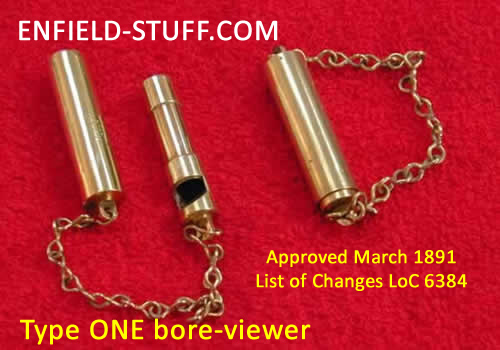 |
TYPE ONE BORE VIEWER
The Reflector, Mirror, Small-arms, .303-inch, makes its first appearance in The List of Changes in British War Materials in March 1891 (LoC 6374). [2]
The drawing and text describe it as brass, with a glass reflector mirror set at 45 degrees and outfitted with a brass outer case attached by a brass chain.
We will define this description as a TYPE ONE bore reflector.
|
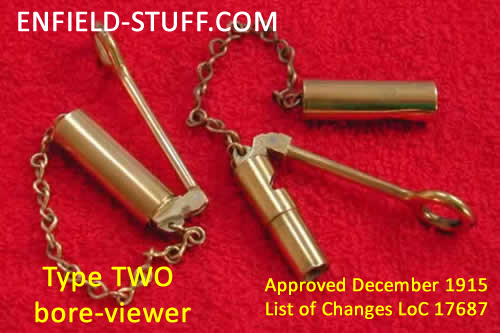 |
TYPE TWO BORE VIEWER
The next entry is almost twenty-five years later, in December 1915 (LoC 17687) [3] introducing Reflectors, mirror, S.A. (Small Arms), .303-inch-Adaptor, Mark I for use with the Canadian Ross rifle and the new Pattern of 1914 rifle. This reflector, with adaptor, is now officially approved for general use with all .303 inch arms.
We will define this description as a TYPE TWO bore reflector.
|
The TYPE TWO reflector is approved for Naval Service in October 1917 (LoC 20131). In August 1925 all reflectors, including those used for machine guns (LoC 7338) are restricted to issuance/use by armourers only. (LoC A-1184) [4]
We have collected information on a number of bore viewers with different marks. These are organized by type and mark, followed by our comments and observations. We welcome any new information that you have to offer.
| Mark |
Sample |
Details |
EFD |
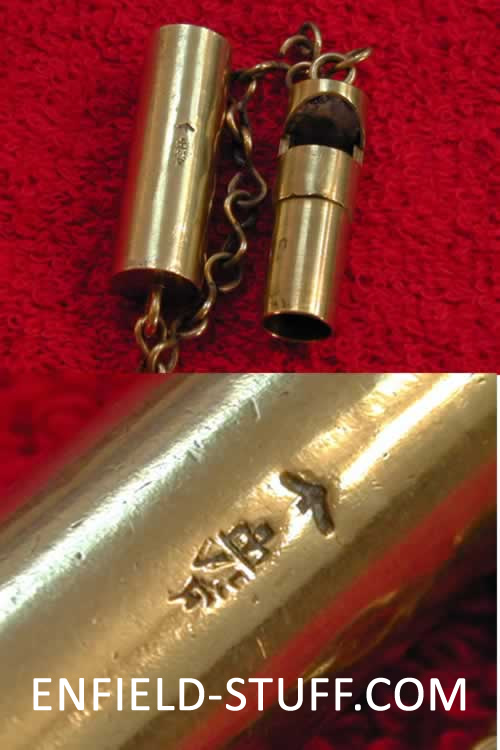
|
Type One: RSAF Enfield inspection. This unit, 1.6" in length, matches the description found in the 1891 List of Changes, although the 4" chain is one inch shorter than specified.
|
EFD
F |
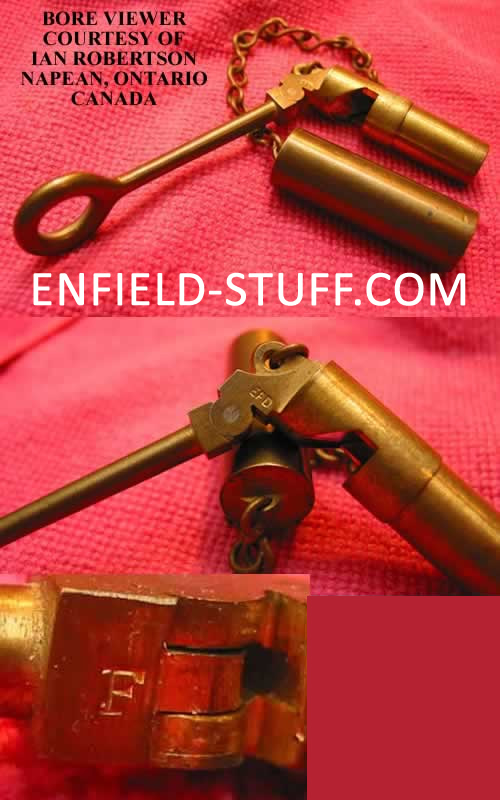
|
Type Two: stamped EFD (RSAF Enfield) in 1/8" letters on the side of the hinge. The hinge is an exceptionally fine piece of machining. 1.6" case body with a 2.75" handle and medium gauge chain 5.5" long. This unit closely matches the description in the 1915 List of Changes for all .303 arms, including Canada's Ross Rifle. Broad arrow marked on case end and on handle. The handle hinge body is also clearly stamped with the letter F.
|
EFD
G |
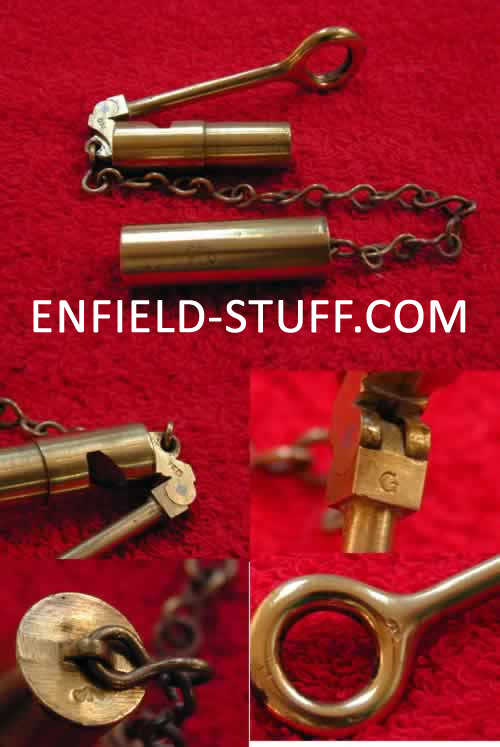
|
Type Two: stamped EFD (RSAF Enfield) in 1/8" letters on the side of the hinge. Same as above except the handle hinge body is clearly stamped with the letter G.
|
EFD
M |
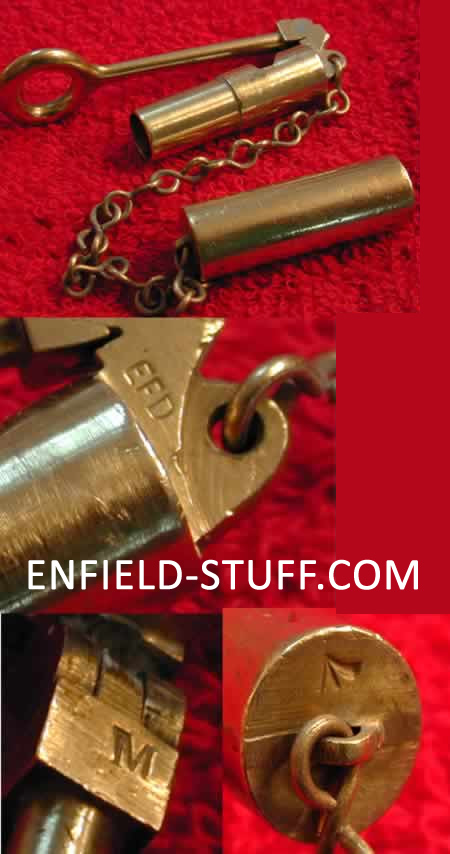
|
Type Two: stamped EFD (RSAF Enfield) in 1/8" letters on the side of the hinge. Same as above except the handle hinge body is clearly stamped with the letter M.
|
EFD
O |
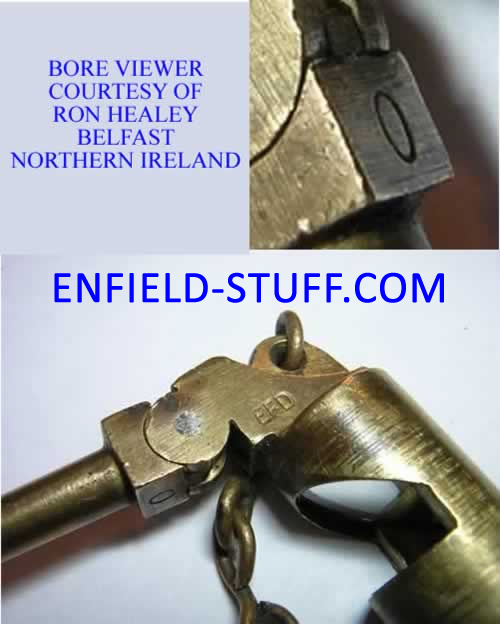
|
Type Two: stamped EFD (RSAF Enfield) in 1/8" letters on the side of the hinge. Same as above except the handle hinge body is clearly stamped with the letter O.
|
CFBC
1916 |
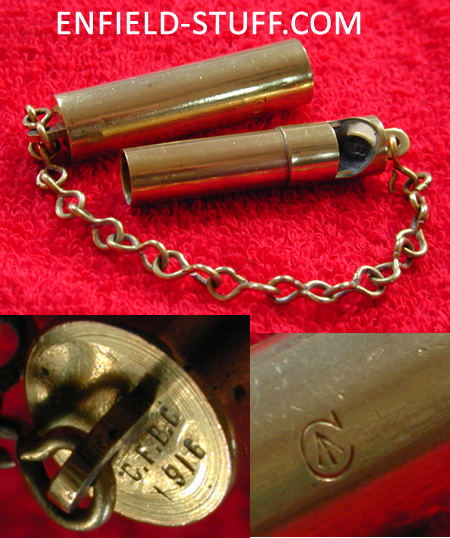
|
Type One: stamped CFBC 1916 in 1/8" letters on the end. Early style Canadian Broad-Arrowmark on the case body. The body is 2.25" in length and the medium gauge chain is 6.5" long. We suspect that this unit was originally intended for Canada's Ross Rifle.
|
CFBC
1916 |
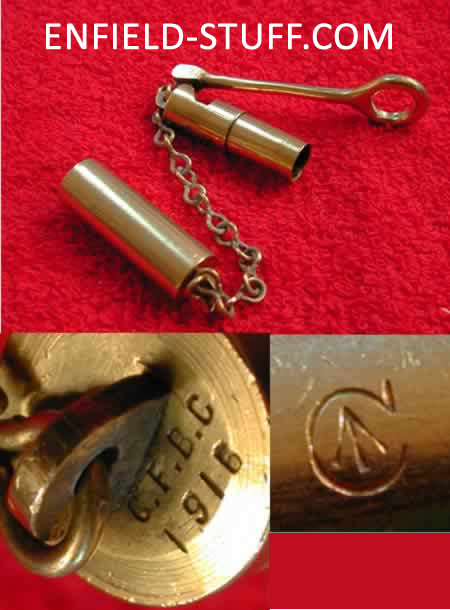
|
Type Two: stamped CFBC 1916 in 1/8" letters on the end. Early style Canadian broad-arrow mark on the 1.6" case body. The 2.75" handle has a well-crafted hinge; the medium gauge chain is 5" long. This unit closely matches the description in the 1915 List of Changes for all .303 arms, including Canada's Ross Rifle.
|
F&S |
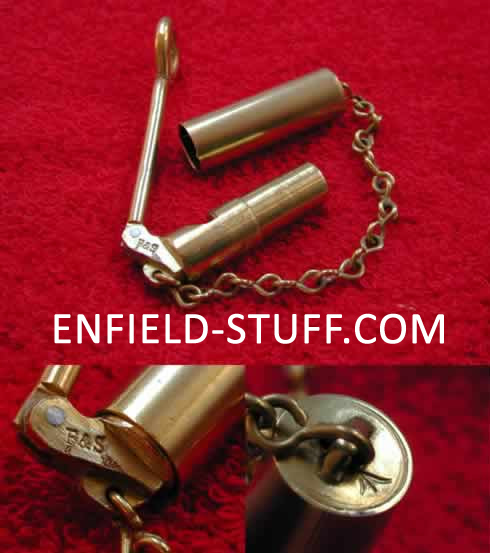
|
Type Two: stamped F&S in 1/8" letters on the hinge body; broad arrow marked on case end and on handle. The body is 1.6" in length and the medium gauge chain is 5" long. The hinge is a simple tab pinned in place.
|
MANROY
F&S |
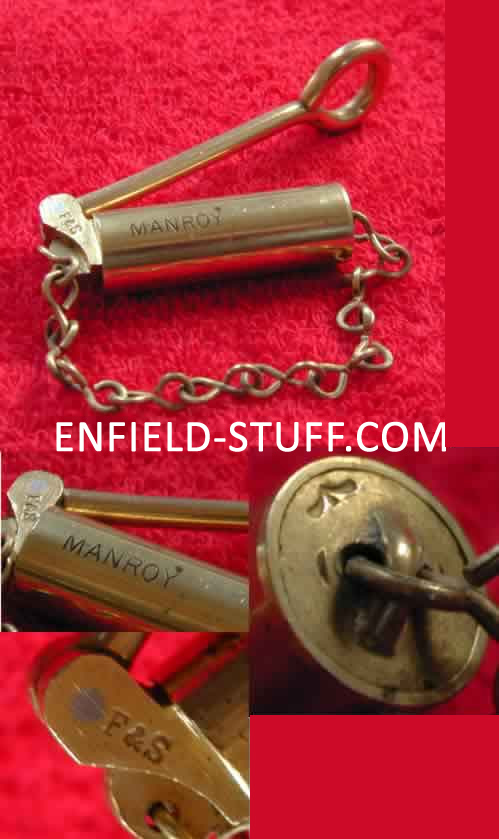
|
Type Two: stamped MANROY on the outer case in two locations. For a while we thought we had discovered another maker's mark - until we noticed F&S stamped on the hinge body. In all respects identical to the F&S above. Lettering on case is first-class work, lined up and even. We surmise that MANROY is the name of the armourer.
|
GILBERT |
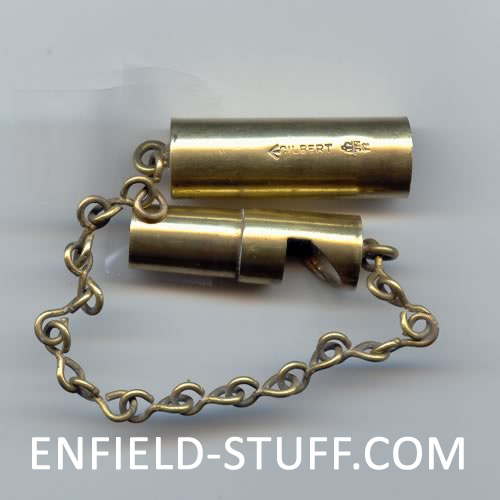
|
Type One: stamped GILBERT in tiny 1/16" letters on the case body; Birmingham Small Arms Co. inspection marked. This unit, 1.6" in length, matches the description found in the 1891 List of Changes, although the 6" chain is one inch longer than specified. This is the only unit of any manufacturer reported with a BSA inspection stamp.
|
GILBERT |
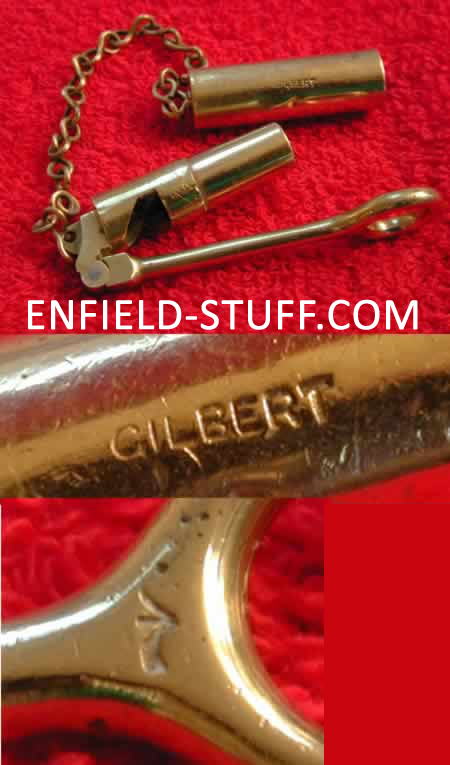
|
Type Two: stamped GILBERT in tiny 1/16" letters on the case body; Broad Arrow marked on case end and on handle. The body is 1.6" in length and the medium gauge chain is 5" long. The hinge is very similar to the EFD Type Two viewer, an equally sophisticated piece of tooling.
|
LAUDER CO.
1915 |
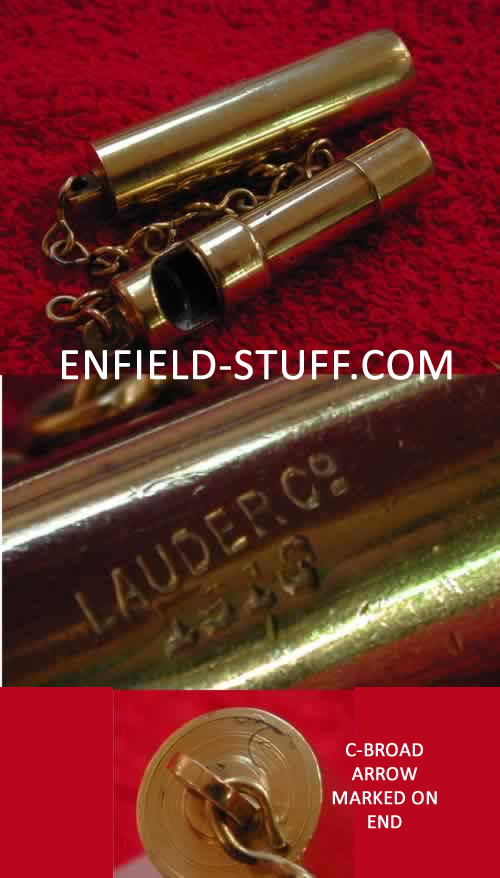
|
Type One: stamped LAUDER CO. 1915 on center body cover and Canadian Broad-Arrow marked on the end. Exceptionally nice workmanship; the body of this unit is 2.25" in length and the fine gauge chain is almost 6.5" long. We suspect that this unit was originally intended for Canada's Ross Rifle.
|
LW
1917 |
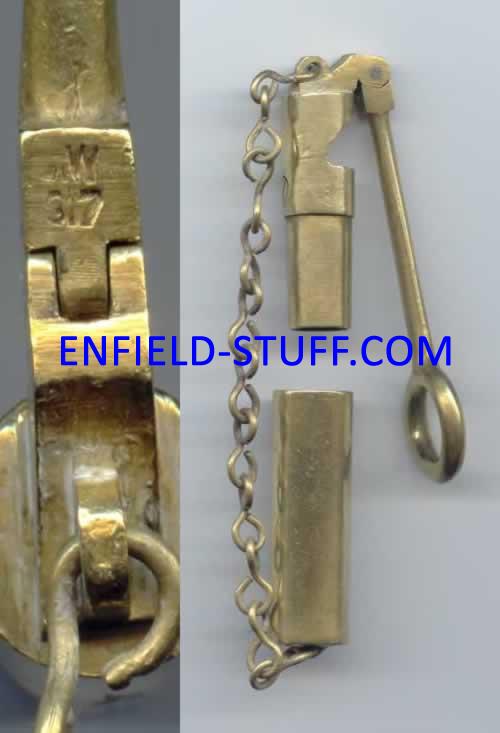
|
Type Two: stamped LW 1917 in 1/8" letters on the handle hinge base; broad arrow marked on case end and on handle. The body is 1.6" in length and the medium gauge chain is 5" long, the hinge very similar to the EFD Type Two viewer, an equally sophisticated piece of tooling.
|
LW
1918 |
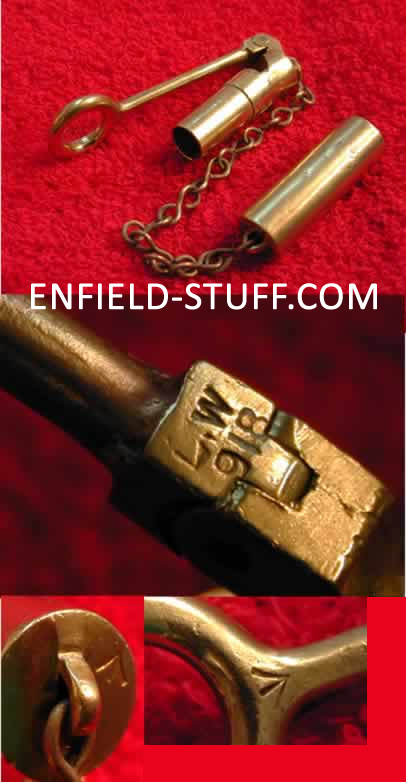
|
Type Two: stamped LW 1918 in 1/8" letters on the handle hinge base; broad arrow marked on case end and on handle. The body is 1.6" in length and the medium gauge chain is 5" long, the hinge very similar to the EFD Type Two viewer, an equally sophisticated piece of tooling.
|
MMCC
1915 |
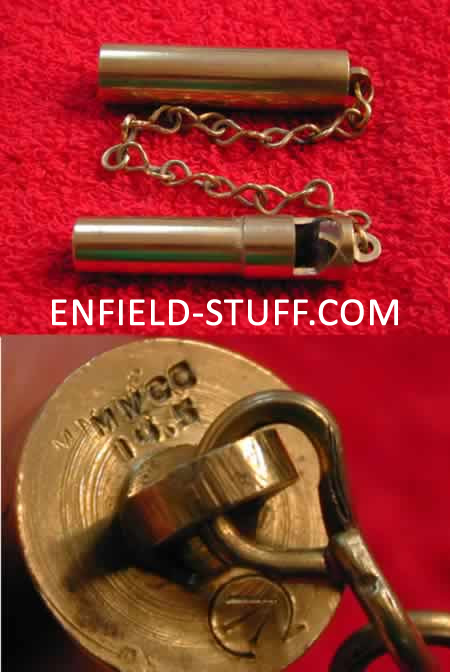
|
Type One: stamped MMCC 1915 in tiny 1/16" letters on the end along with an early style Canadian Broad-Arrow mark. The body is 2.25" in length and the medium gauge chain is 6" long. Again, we suspect that this unit was originally intended for Canada's Ross Rifle.
|
MMCC
1915 |
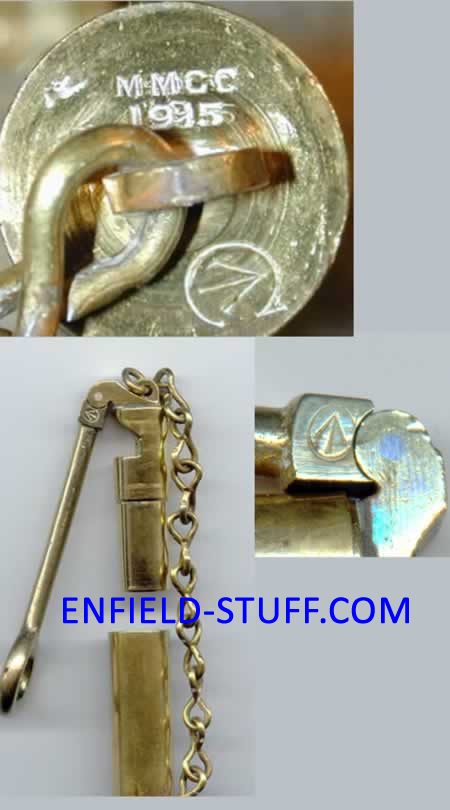
|
Type Two: stamped MMCC 1912 in 1/16" letters on the end. Early style Canadian Broad-Arrow mark on the 1.6" case body. The 2.75" handle has a well-crafted hinge; the medium gauge chain is 5" long. This unit closely matches the description in the 1915 List of Changes for all .303 arms, including Canada's Ross Rifle.
|
.22 CALIBER |
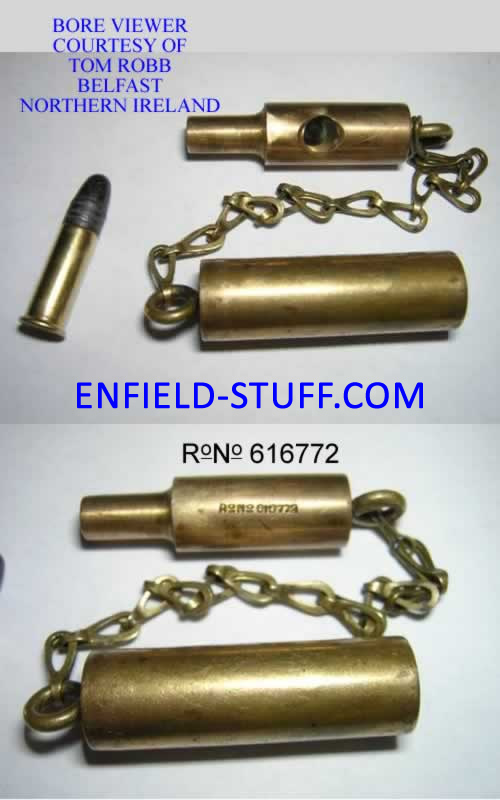
|
Type One: stamped RoNo 616772 in 1/8" letters on the case; no Broad Arrow or other identifying marks. The medium gauge chain is made of stamped and folded links, unlike the simple round wire noted on .303 caliber bore viewers.
|
.22 CALIBER |
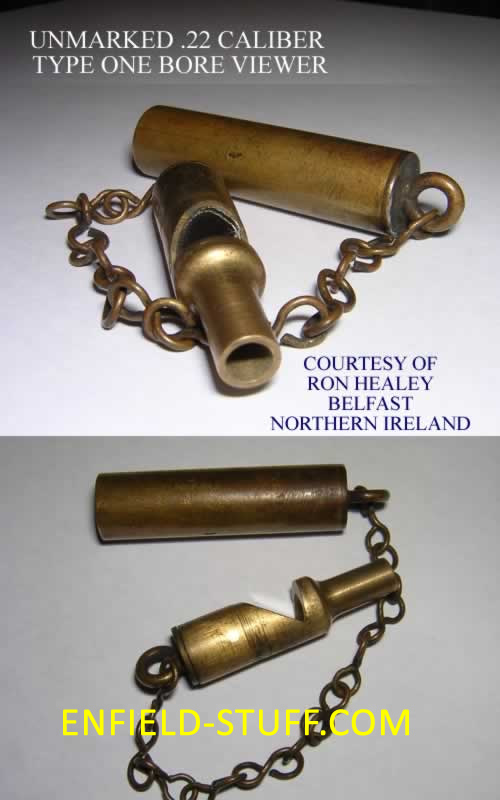
|
Type One: Identical to the one above except NO identifying marks whatever. The unit has the chain made from simple round wire noted on .303 caliber bore viewers.
|
.50 CALIBER
ELE Co Ld
1940 |
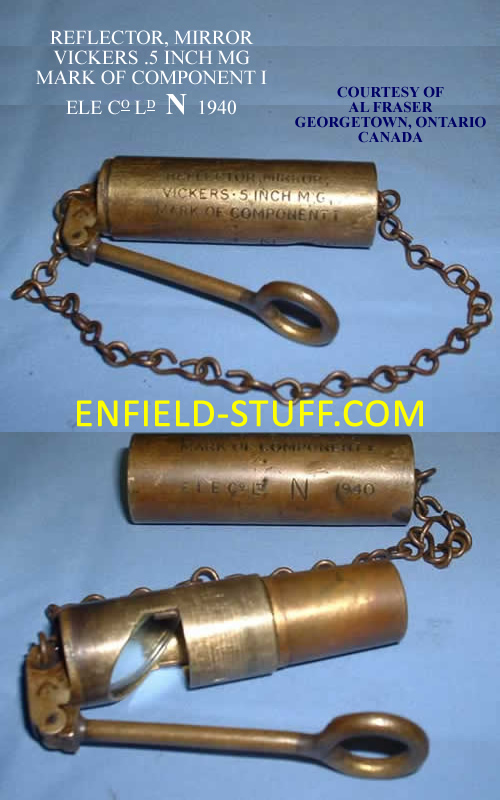
|
Type Two: Identical to the .303 family of viewers, except significantly larger and clearly marked VICKERS .5 INCH MG; Broad Arrow and Navy marked, dated 1940. Maker ELE Co Ld. unknown.
|
Notes & Sources
[1] Harrison Forman (1904-1978) was an American photographer and journalist. He wrote for The New York Times and National Geographic. During World War II he reported from China and interviewed Mao Zedong. His collection of diaries and fifty thousand photographs are now at American Geographical Society Library at University of Wisconsin–Milwaukee. Photo courtesy of University of Wisconsin-Milwaukee, AGSL Digital Photo Archive – Asia and Middle East. https://collections.lib.uwm.edu/digital/collection/agsphoto/id/23550/
[2] List of Changes in British War Material in Relation to Edged Weapons, Firearms and Associated Ammunition and Accoutrements. Volume II, page 49. Skennerton, Ian, editor.
[3] List of Changes in British War Material in Relation to Edged Weapons, Firearms and Associated Ammunition and Accoutrements. Volume IV, page 125. Skennerton, Ian, editor.
[4] List of Changes in British War Material in Relation to Edged Weapons, Firearms and Associated Ammunition and Accoutrements. Volume V, page 114. Skennerton, Ian, editor.





















